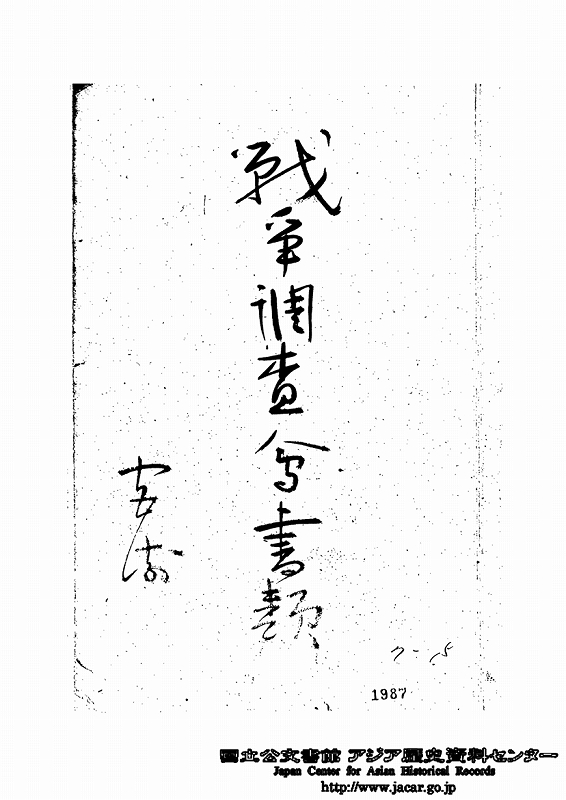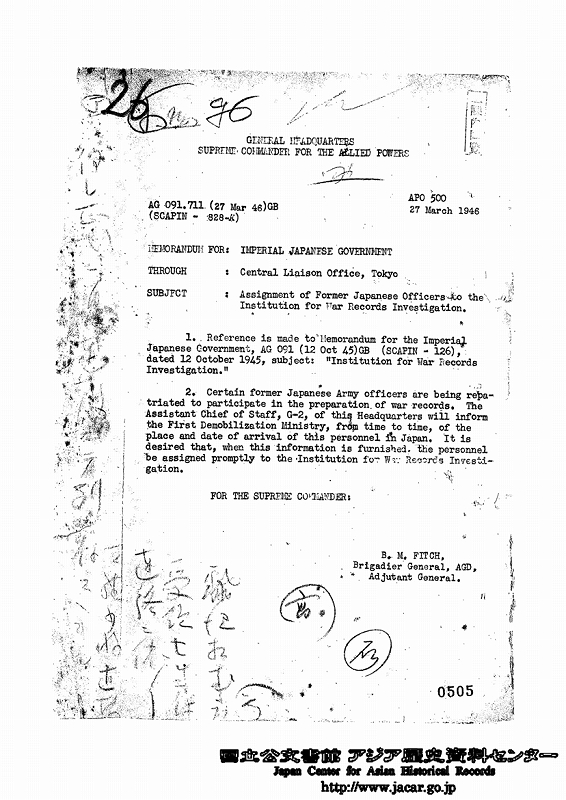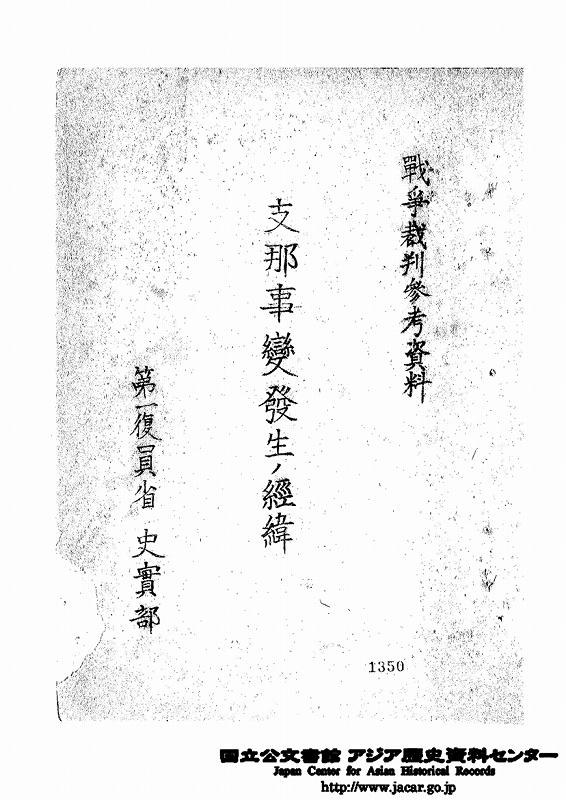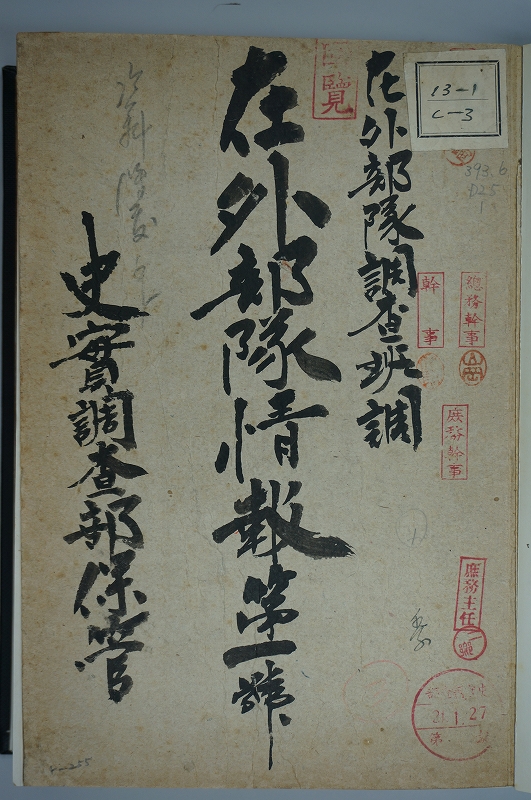
Top Page > Search by topic within "Japanese Soldier Repatriation after World War Two, as Seen in Archival Records" > Column No.3 [ Survey of the War and the Investigation of Military History ]
Column No.3 [ Survey of the War and the Investigation of Military History ]
Soon after the end of the Pacific War, two kinds of Japanese organizations were established to survey and investigate the war.
These organizations were the Investigation Council for the Greater East Asia War (大東亜戦争調査会) established beneath the Cabinet and the Department for Investigation of Military History (史実部 or 史実調査部) of the 1st Ministry of Demobilization and the 2nd Ministry of Demobilization.
There was a significant difference between the Investigation Council for the War and the Department for Investigation of Military History.
While the former was established by the will of the Shidehara Cabinet of Japan, the latter was organized by the order of the General Head Qurters (GHQ) of Allied Forces.
1. The Investigation Council for the War: Survey Activity by The Japanese government
The Investigation Council for the Greater East Asia War was organized by the prime minister of Japan through the October 30th 1945 Cabinet decision “About the Investigation for the Cause and Facts of Defeat”. The November 20th 1945 Cabinet decision for “the governmental organization of an Investigation council for the Greater East Asia War” followed it.
It was necessary to ask for American consent for the establishment of the association as Japan was under the occupation. However, it seems that there also existed the strong will of the Japanese government to establish such an institution.
According to government organization revisions on January 11th, 1946, the association’s full name was officially changed to “The Investigation Council for the War (戦争調査会)” by the command of Tokyo’s General Headquarters (GHQ)”.
The Investigation Council for the War had five departments: 1st Department (politics, foreign policy), 2nd Department (military affairs), 3rd Department (finance, economy), 4th Department (ideology, culture), and 5th Department (science, technology). These departments were set up to investigate comprehensively the cause of the Pacific War as well as the problem of the wartime structure and the supreme command and operations.
Members were extensively recruited from political, academic and economic sectors.
In addition, former army and navy staff participated to gather related materials and analyze them, because the investigation of the military facts was also sought (Kunugi 1996, pp. 83-85).

Image 1. Miyazaki Shuichi “Documents Related to the Survey Association of the War”
(JACAR Ref:C14061079700)
The discharged Lieutenant General Shuichi Miyazaki was a typical figure of the members. He was the Chief of the Operations Department of the General Staff Office when the war ended. After that, Miyazaki served as the Chief of the 1st Department of the General Staff Office from the 15th of August 1945 to the 30th of November 1945. On December 1st, 1945, the 1st Ministry of Demobilization was established and he served as the Chief of the Department for the Investigation of Military History and was in charge of post-war settlements and demobilizations as well as investigation.
Miyazaki also took part in the Investigation Council for the War, as the status of the chief of the Department for Investigation of Military History. You can browse documents related to the Investigation Council for the War that were collected by Miyazaki.
These documents are included in the series “The National Institute for Defense Studies, Ministry of Defense>Army Records (Rid of Dainikki)>Bunko>Miyazaki” (「陸軍一般史料‐文庫‐宮崎」).Reference code: C14061079700.(※Image 1)
The Allied Council for Japan (対日理事会) was established by the United States, Britain, Soviet Union and Republic of China on December 28th 1945 as an advisory body for GHQ The Soviet Union and Britain criticized the Investigation Council for the War for having staff members who were former army and navy members, as well as their scientist collaborators.
As a result, the United States instructed the Japanese government to abolish the association, because the United States was concerned that conflict among members of the Allied Council for Japan might be long to resolve. The Japanese government carried out the instructions of the GHQ, and the Investigation Council for the War was closed down during its first year of operations on September 30th 1946 (Tomita 2013, pp.103-105).
2. The Investigation by Former Army and Navy Staff Members: – The Department for Investigation of Military History
As mentioned above, the Departments for Investigation of Military History of the Ministry of the 1st Demobilization and the Ministry of the 2nd Demobilization as established by a GHQ order sent out on October 12th, 1945.
The GHQ order, “Institution for War Records Investigation” (SCAPIN-126), was sent to the Japanese government, instructing the gathering of records related the Pacific War (Tanaka 2009, p372).

Image 2. SCAPIN-828
(JACAR Ref:C15010010300)
About six months later, the order named SCAPIN-828 was released on the 27th of March 1946. By the order, Brigadier General of GHQ, B. M. Fitch requested the Japanese government to recruit former military officers for the Institution for War Records Investigation. GHQ’s intentions for the institution are clearly seen in the order. You can browse that document in the JACAR database (Reference code: C15010010300.(※Image 2)
Lieutenant General Miyazaki Shuichi wrote in his diary that “We were required to carry out a huge amount of investigation” (24th October 1945). Miyazaki also wrote that “The 2nd Section is scrutinizing the organization of the Department for Investigation of Military History” (30th October 1945) (『宮崎周一日誌』,防衛研究所所蔵:中央‐作戦指導‐558). It is clear that the establishment of a Department for Investigation of Military History was in accordance to GHQ orders.
As mentioned above, the General Staff Office was abolished and therefore the Chief and Deputy Chief of the General Staff retired on the 15th of October 1945. However, according to Lieutenant General Arisue Seizo’s recollection, other staff members of the General Staff Office continued working for the Department for Investigation of Military History. Arisue was the Chief of the 2nd Department of the General Staff Office, and was also in charge of negotiation with GHQ. Arisue arranged materials related to the war history for being edited. He wrote that after the abolishment of the General Staff Office, Lieutenant General Miyazaki Shuichi (Chief of the 1st Department for operations, formation, logistics) and Colonel Hattori Takushiro (Chief of the Operations Section) as well as other staff were transferred from the General Staff Office to the Army Ministry, and they served the Department for Investigation of Military History. Although Arisue wrote that he was the Chief of the 2nd Department but was absent during this process, the section staff and other junior staff of the 2nd Department (covering sections on the Soviet Union, Britain, United States, and China) and 3rd Department (related transportation and communications) were also temporarily transferred to the Department for Investigation of Military History for “investigation of matters which were required by GHQ and study the measures to the problem of Japanese war criminals” (Arisue 1976, p200).
There exist some documents which suggest that the General Staff Office might have started the Department for Investigation of Military History before the end of the Pacific War.
There is a document titled “The Index of the Operation in the Philippines (比島作戦記録目録)” released in the JACAR database. The beginning part of this record mentions that this record was first drafted by the Department for Investigation of Military History of the General Staff Office (located in Nakano) and was supplemented later. It also mentions that Major General Suzuki Kenji of the Department for Investigation of Military History of the General Staff Office drafted the records between spring and autumn in 1943.(JACAR Ref:C14020645300)
The exact structure of the Department for Investigation of Military History of General Staff Office remains unclear. The Department for Investigation of Military History of General Staff Office may or may not have a connection with the Department for Investigation of Military History of the 1st Ministry of Demobilization. However, members of the the department of the 1st Department of the General Staff Office, were transferred to the Army Ministry after the end of war and formed the main staff of the Department for Investigation of Military History. Thus, it seems that there was some continuity between the Department for the Investigation of Military History of the General Staff Office and the other one of the 1st Ministry of Demobilization.
As for the Japanese Navy, the Research Committee for the Lesson of the Greater East Asia War (大東亜戦争戦訓調査委員会) was established quite early after the War in the Navy Ministry “to investigate the cause of defeat of the War and to study the measures for the construction of “New Japan”” (Navy Gazette (海軍公報) No.5175, September 3rd 1945). (JACAR Ref:C12070530400).
Furthermore, the Committee for Collecting Operation Related Materials (作戦関係資料蒐集委員会) was also established in the Navy Ministry “for collecting and arranging operation related materials to offer to GHQ” (Navy Gazette (海軍公報) No.5194, October 2nd 1945). (JACAR Ref:C12070530500).
The adjutant of the Navy Ministry reported on the 12th of October 1945 as follows: “the calling of naval officers for hearings by the Allied Forces Command about materials related war histories are recently quite frequent”.
According to this adjutant’s report, the Navy Ministry required “naval officers to be designated [by GHQ] to have a preparatory meeting at the Committee for Collecting Operation Related Materials [located in Naval War College, Meguro] in advance for the appropriate supply of the exact materials to GHQ and to make a report after presenting to GHQ”. It seems that the Navy Ministry staff were initially quite caution with the GHQ activities (海軍省副官「聯合軍ヨリ戦史資料聴取ノ目的ヲ以テ召喚セラルル諸官ノ行動ニ関スル件照会」1945年10月12日,防衛研究所所蔵:①中央‐終戦処理‐23).
Although we can’t browse JACAR database documents explaining how the Department for Investigation of Military History of Navy was established after the abolishment of the Naval General Staff Office on the 15th of October 1945 and Navy Ministry on 30th November 1945, the department, together with the correspondent Department of Army, was officially established under the 2nd Ministry of Demobilization on 1st December 1945.

Image 3. The Department for Investigation of Military History, 1st Ministry of Demobilization “The Details of the Outbreak of Second Sino-Japanese War”
(JACAR Ref:C11110470800)
How did Japanese Army and Navy Officers investigate military history?
According to the “Guideline for Investigating Military History” (史実調査要領), which was created by the Military Affairs Section of the Army Ministry on the 19th of November 1945, their main policy was “researching military history of army direction at the Manchurian Incident, Sino-Japanese War (Shina Jihen) and the Greater East Asia War.” The method of the research was regulated as follows: Firstly collect and arrange materials related to military history as well as investigate military history demanded by the GHQ; Secondly, complete the investigation for military history based on these materials (軍務課「史実調査要領ニ関スル件」1945年11月25日,防衛研究所所蔵:文庫‐柚‐24).
It suggests that the staff of the Department for the Investigation of Military History intended to promote the investigation based on their own initiative and interests and considered the order by GHQ as secondary.(※Image 3)
The Department for Investigation of Military History was criticized by the representative of the Soviet Union of Allied Council for Japan at its 16th Conference held on October 2 of 1947.
The Soviet Union mentioned as follows: “There are discharged officers engaged in operation as well as intelligence activities in The Department for Investigation of Military History, and they are investigating and studying the Pacific War. Why such activity is needed at Demobilization Agency…. Although Japan’s General Staff Office was officially abolished, staff officers still exist in the Demobilization Agency. The difference between the past and the present is only their clothes. They are now wearing business suits instead of military uniforms. We are greatly concerned that the Japanese government is trying to justify past military actions of the General Staff Office, taking advantage of the trust of the Supreme Commander of the GHQ” (Ministry of Foreign Affairs 1979, P141-142).

Image 4 Subsection for Research of Japanese Naval Units Overseas, General Affairs Section, General Affairs Department, 2nd Bureau of Demobilization “Information about Japanese Naval Units Overseas, Volume 1” (holding at the National Showa Memorial Museum)
(昭和館所蔵)
Thanks to the creation of materials related to the Supreme Command and operations of the Army and Navy by The Department for Investigation of Military History, we are now able to know the direction and operation as well as the movements of each troop in detail, which might have been difficult to know if there was destruction and/or seizure.(※Image 4)
On June 15th, 1946, the two ministries dealing with demobilization were unified. The Department for Investigation of Military History of the 1st and 2nd Ministry of Demobilization were reorganized into the Department for Investigation of Military History of 1st Bureau of Demobilization and the Document Arrangement Department of the 2nd Bureau of Demobilization under the Demobilization Agency. The Demobilization Agency was abolished on October 15th of 1947, and the Department for Investigation of Military History of 1st Bureau of Demobilization was reorganized to the Document Arrangement Department of 1st Bureau of Demobilization under the jurisdiction of the Ministry of Welfare. The Document Arrangement Department of the 2nd Bureau of Demobilization was also reorganized under the jurisdiction of the Prime Minister's Agency at the same time.
Then, the 1st Bureau of Demobilization of the Ministry of Welfare and the 2nd Bureau of Demobilization of the Prime Minister's Agency were unified to the Bureau of Demobilization under jurisdiction of the Ministry of Welfare on January 1st, 1948. The Department for Investigation of Military History related to the Army was transferred to the Document Arrangement Department and the Document Arrangement Department related to the Navy was reorganized to Subsection for Investigation of Military History, Liquidating Department, 2nd Bureau of Demobilization.
On May 31st, 1948, the Demobilization Agency was transferred to the Demobilization Bureau of the Repatriation Relief Agency under the Ministry of Welfare; the Army related investigation section was reorganized into the Document Arrangement Department of the Demobilization Bureau of Repatriation Relief Agency, and Navy related investigation section was reorganized into the Materials Section, Liquidating Department of 2nd Bureau of Demobilization.
In the end, these section for investigation of military history disappeared when the Repatriation Relief Agency was abolished on January 13th, 1952.
With the JACAR database, you can browse many of those military history documents created by these departments for the investigation of military history. Try searching to read documents created after the war by using JACAR Glossary Search.
【 Bibliography 】(the Japanese syllabary)
- Arisue Seizo (有末精三) 1976,『終戦秘史 有末機関長の手記』.
- Kunugi Toshihiro (功刀俊洋) 1996,「大東亜戦争調査会の戦争責任観」(『歴史評論』第557号、September 1996).
- Ministry of Foreign Affairs ed. (外務省編) 1979,『初期対日占領政策 朝海浩一郎報告書(下)』(毎日新聞社).
- Kure Local Demobilization Bureau (呉地方復員局)『終戦関係綴(昭和二十~二十一年)』(防衛研究所所蔵:①中央‐終戦処理‐23).
- The Military History Society of Japan ed. (軍事史学会) 2003,『大本営陸軍部作戦部長 宮崎周一中将日誌』(錦正社).
- 1st Ministry of Demobilization (第一復員省)『昭和二〇、八、一八~二〇、一二、二八 陸軍復員関係史料綴』(防衛研究所所蔵:文庫‐柚‐24).
- Tanaka Hiromi (田中宏巳) 2009,「史実調査部と地図の行方」(小林茂編『近代日本の地図作製とアジア太平洋地域 「外邦図」へのアプローチ』大阪大学出版会、第四章).
- Tomita Keiichiro (冨田圭一郎) 2013,「敗戦直後の戦争調査会について―政策を検証する試みとその挫折―」(『レファレンス』平成25年1月号、January 2013).
- Harukawa Yumiko (春川由美子) 1995,「復員省と占領政策」(『軍事史学』第31号、September 1995).
- Miyazaki Shuichi (宮崎周一)『昭和二十年九月二十五日~昭和二十年六月十四日 宮崎周一日誌 復員時代日誌(1)』(防衛省防衛研究所所蔵:中央‐作戦指導‐558).
- 「JACAR Ref.C14061079700、戦争調査会書類 (文庫-宮崎-95) (防衛省防衛研究所)」
- 「JACAR Ref.C15010010300、26.戦争記録調査機関に関する件 (中央-終戦処理-3) (防衛省防衛研究所)」
- 「JACAR Ref.C14020645300、比島作戦記録目録 (比島-全般-4) (防衛省防衛研究所)」
- 「JACAR Ref.C12070530500、10月 (0法令-海軍(二復)公報-160) (防衛省防衛研究所)」
- 「JACAR Ref.C11110470800、支那事変発生の経緯 戦争裁判参考資料 (支那-支那事変全般-189) (防衛省防衛研究所)」
![Search by topic within "Japanese Soldier Repatriation after World War Two, as Seen in Archival Records" [JACAR Glossary]](../../images/logo.png)
